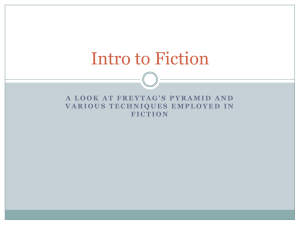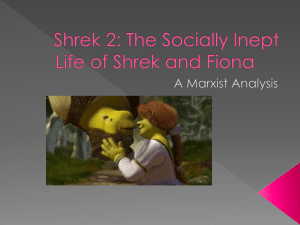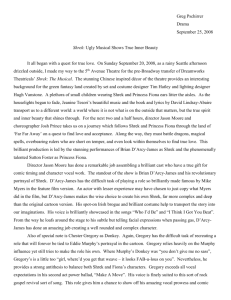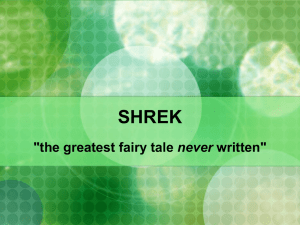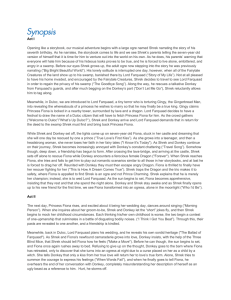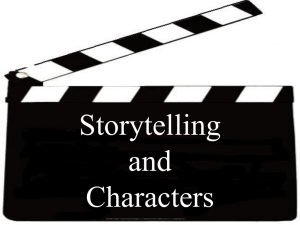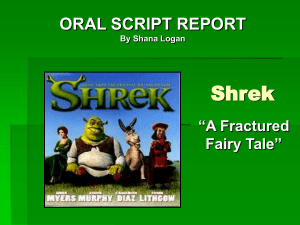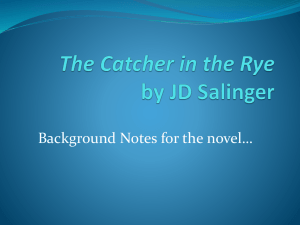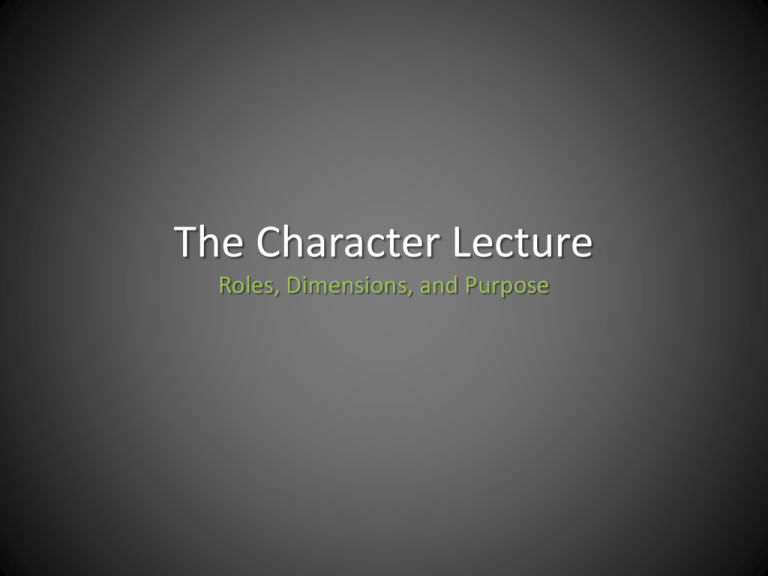
The Character Lecture
Roles, Dimensions, and Purpose
This PowerPoint is copyright ©2013
by Diane Orsini.
All rights reserved.
A character is a made-up person in
a story.
As an author, you get to make up
this person.
This fictional person may be based
on some aspect of yourself or of
someone you know.
This character will have a designated
role in your story, which you must
direct and develop.
This PowerPoint intends to help you
answer three questions about a
character in development:
•
•
•
What role should this character
play?
Will this character be round or
flat?
Will this character be static or
dynamic?
Let’s begin with character roles.
Like a casting director, you need to
know which actor can play which role.
Here is your cast:
•
•
•
•
The Protagonist
The Antagonist
The Foil
The Stock Character
In your story, you will need to fill
each role at least once.
The Protagonist
The Protagonist is the lead character—the
focus of audience identification. We expect that
the character will change in some way,
becoming a better (or worse) version of him or
her self.
In the
eponymous
films, Shrek
becomes a
better, more
fulfilled version
of himself. He
earns Fiona’s
love.
Fiona also
changes. At first
obsessed with
protocols and
externals, she gives
up expectations for
love of the leastlikely candidate in
animation history.
She accepts her true nature as an
ogress and finds personal and marital
fulfillment as a result.
The happiness Shrek and Fiona find
together is a promise to all of us.
Not all protagonists change for the
better, however.
Some change for the worse-- a
whole lot worse.
Michael Corleone, the
protagonist of The
Godfather books and
films, changes. For his
father’s safety, he
sacrifices his ideals
and integrity to
become the thing he
most despises: a mob
boss.
Like all sacrifices, his
cannot be unmade. He
alienates his wife, has
his own brother
murdered, and is
shunned by his
children. Our last image
is of a man who has
everything—and no
one.
In the last scene of The Godfather,
Part II, we see him as utterly,
eternally alone.
The price he pays for victory is a
warning to all of us.
Change in a Protagonist is not
possible without conflict.
There is no greater source of
conflict that a bona-fide
Antagonist.
An Antagonist is the character in
conflict or competition with the
Protagonist.
Lord Farquaad competes
with Shrek for control of
the swamp and for
Fiona’s hand in
marriage.
Prince Charming
competes with
Shrek for control
of Far, Far Away
and for Fiona.
Conflict in the Shrek series results
from their conviction that their wealth
and conventional appearances make
them better for Fiona than Shrek.
The audience is aware, however, that
neither character would make a great
monarch, and that neither loves Fiona.
Each would seek to conventionalize
her against her will.
We watch to see if trickery and
deceit win out over true love.
In the Shrek films, they do not win.
Nor do they win in Snow White
and the Huntsman.
Queen Ravenna, the antagonist of Snow White
and the Huntsman, deceives and betrays
virtually everyone, even her brother, but ends
up defeated by the protagonist, Snow White.
Keep in mind that antagonists are
not always human—or even alive.
In Finding Nemo, the
antagonists are the
Pacific Ocean, which
separates Marlin from
Nemo, and the fish
tank which keeps
Nemo prisoner.
Protagonists and antagonists are
primary characters.
For realistic fiction, there must also
be the secondary characters.
A Foil is a character whose purpose
is to point up a specific quality in a
Protagonist by contrast.
Donkey is Shrek’s
best friend.
He is also an excellent
foil. His cowardice and
indecision highlight
Shrek’s bravery and
confidence by contrast.
In return, his openness and
friendliness highlight Shrek’s
stubbornness and poor social skills by
contrast.
A fictional world must be inhabited by
more than just the main cast of
protagonists, antagonists, and foils.
Often, authors rely on a culturallyprovided warehouse stuffed to the
rafters with Stock Characters.
A stock character is an instantlyrecognizable type.
These characters are so familiar
that an author doesn’t always
develop them.
Consider the ubiquity of the “TV
mom.” Think Modern Family or The
Neighbors. Or the “hooker with a
heart of gold.” Think Pretty Woman—
and even House, M.D.
Consider one stock character in
particular:
The soldier
more
committed to a
cause than to
society’s ideals:
Avatar’s Col.
Miles Quaritch
is an example.
So is Col.
Nathan
Jessup from A
Few Good
Men
You can see the type in Gen. W.R.
Monger from Monsters vs. Aliens
The Mean-Girl
Cheerleader is also
frequently deployed.
• Santana Lopez of
Glee
• Cordelia Chase
of Buffy, the
Vampire Slayer
• Libby Chessler of
Sabrina, the
Teen-Age Witch
Some authors go beyond “stock”
into stereotype.
What more
needs to be
said?
We are not those authors.
We are authors who determine
dimension—
whether a character will be flat or
round.
A round character offers the threedimensional illusion that he or she has
a past, a present, and a future.
Round characters are sometimes
more vivid than people we actually
know.
Consider Meryl Streep, whose
characters are so three-dimensional
and so suffused with an inner life that
she has been nominated 27 times for
Academy awards.
Think of the
control-freak bossfrom-hell,
Miranda Priestly
Or Donna,
the freespirit hippie
mom
Or even ‘Margaret
Thatcher,’ Prime
Minister of England
Each character’s unique inner life
shines through Streep’s portrait.
Miranda Priestly, Donna, and
‘Margaret Thatcher’ are round
characters.
But characters can also be flat.
Flat characters remain twodimensional. We know nothing about
where they came from or where
they’re going, or what they most
desire.
The blue whale in Finding Nemo is a
flat character.
We know nothing about where the
whale comes from or why he
wants to help. He’s a baleen limo.
By contrast, we know a lot more about Dragon’s
inner life: she’s disappointed about her failure in the
castle, she loves Donkey, and she sincerely wants to
help Shrek save Fiona.
The bartender in
the Ritz Bar in
“Babylon Revisited”
is a flat character.
The whale and the bartender—and the
waitress in “Hills Like White
Elephants”— perform necessary
functions to advance the plot.
But they don’t even get names.
All characters have a purpose. Let us
now consider what some characters
do.
The Prime Directive for all
protagonists is this:
Change or die.
This is not negotiable.
Even reality shows like Jersey Shore
feature highly-contrived but
recognizable arcs.
The story arc is the vehicle of change:
the character moves from a state of
grace to a state of damnation, and
sometimes back to a state of grace.
Remember him?
Change occurs in a character when he
or she discovers something so
important that nothing in his or her
world can ever be the same.
Luke discovers Darth
Vader is his father.
Nemo discovers that his
malformed fin is no obstacle to his
life or his happiness.
You get the idea.
•
•
•
•
•
•
•
After the epiphany, the character takes a
different course of action, in spite of the
risks.
Luke Skywalker chooses to redeem Darth Vader
Shrek chooses to fight for Fiona
Snow White chooses to fight for her kingdom
Harry Potter chooses to confront Voldemort
Frodo chooses to take the Ring to Mordor
Michael Corleone chooses to save his father’s life
Charlie Wales chooses to face reality without people from his
previous life
• Marlin chooses to let go
• And so on . . .
Not all change, however, is good.
Remember Michael Corleone and
Queen Ravenna?
Frodo cracks under
pressure, can’t live with
the knowledge, and leaves
the Shire for the Grey
Havens.
Sometimes, a character refuses to
change.
That character almost always ends
up dead.
Like Jay Gatsby (oops! Spoiler Alert!)
Or Captain Ahab
Or, like Dr.
House, he
ends up in a
TV drama
rolling
weekly
through the
same plot for
eight years.
Foil characters may also change
but don’t always have to.
Donkey is not the protagonist, but he changes, moving
from fearing Dragon to loving her.
Sometimes, the foil doesn’t change,
and this refusal highlights the heroic
aspects of a protagonist.
Boromir yields to
the Ring’s
temptation. This
highlights
Aragorn’s selfcontrol.
Sometimes, the foil doesn’t change
because he or she doesn’t need to.
Morpheus is already
evolved. His role is to
initiate Neo into the
truth about the
Matrix.
Obi-Wan
Kenobi has
survived his
own test and
now chooses
to initiate Luke
into the ways
of the Force.
Dr. Cockroach, who
has already
undergone his own
transformation,
initiates Susan into
her new life as a
monster in Monsters
vs. Aliens
It is now your responsibility to
bring this new awareness into your
fiction. . .
. . . And to have some fun doing it.
Good luck!
The End.


